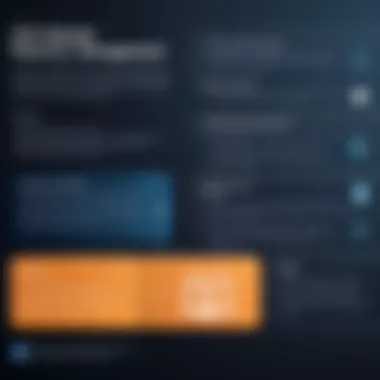Central Patch Management: Strategies for Success


Intro
In an era driven by technological advancement, organizations increasingly face the daunting task of managing their software environments. Central patch management emerges as a vital component in ensuring a secure and efficient operational framework. As software components become more intricate, the risks associated with vulnerabilities multiply. This section explores foundational insights into central patch management, dissecting its significance and its indispensable role in today’s business landscape.
Software Category Overview
Definition and Importance
Central patch management refers to the systematic process of managing software updates within a networked environment. This involves identifying, acquiring, testing, and deploying patches across various systems. The importance of a robust patch management strategy cannot be overstated. It plays a critical role in maintaining security, preventing data breaches, and ensuring compliance with regulations such as GDPR and HIPAA.
In a world where cyber threats are constantly evolving, organizations must remain proactive. A well-implemented central patch management system minimizes vulnerabilities while maximizing system performance. It also supports operational efficiency by reducing downtime and ensuring that all systems function optimally.
Key Characteristics
Several key characteristics define effective central patch management:
- Automation: Automation ensures timely updates, reducing the human error factor.
- Inventory Management: Keeping track of all software assets assists in identifying what needs attention.
- Testing Procedures: Patch testing is crucial to avoid compatibility issues.
- Reporting and Analytics: Detailed reporting aids in auditing and compliance efforts.
These elements work together to create a cohesive and comprehensive management approach.
Comparative Analysis of Top Software Options
Feature Comparison
When evaluating software solutions for central patch management, it is essential to consider specific features that enhance functionality. For instance:
- Microsoft System Center Configuration Manager (SCCM): Highly integrates with Microsoft environments and offers extensive reporting capabilities.
- Ivanti Patch Management: Known for automation and patch testing efficiencies, particularly across diverse platforms.
- ManageEngine Patch Manager Plus: Offers a user-friendly interface with robust reporting features, ideal for small to medium-sized enterprises.
These software options differ in terms of approach and usability, thus catering to various organizational needs.
Pricing Models
Pricing models for patch management solutions can vary significantly based on features, deployment options, and organizational size. Common pricing structures include:
- Subscription-Based: Monthly or annual fees that scale with features.
- Perpetual Licensing: One-time purchase with optional paid updates.
- Tiered Pricing: Different levels based on the number of endpoints managed.
Understanding the financial implications helps decision-makers align their budget effectively.
Effective central patch management is not just about fixing bugs; it is about creating a resilient and responsive IT environment.
Understanding Central Patch Management
Central patch management refers to the systematic approach organizations implement to manage updates and patches for their software systems and applications. It is relevant due to the increasing complexity of IT environments and the growing threat landscape. The necessity for central patch management arises primarily from the need to protect sensitive information and ensure compliance with regulatory standards. As systems become interconnected and software dependencies deepen, the effectiveness of patch management directly influences an organization's ability to mitigate security risks.
Definition of Central Patch Management
Central patch management is defined as the process of managing patches and updates for software applications and operating systems from a centralized location. This method allows IT departments to monitor, deploy, and document the application of patches, ensuring consistency and adherence to corporate policies. The core objective is to maintain system integrity by reducing vulnerabilities that can be exploited by cyber threats. This management typically involves several activities, including:
- Identifying Updates: Recognizing which patches are available and necessary based on systems in operation.
- Testing: Assessing the compatibility and effectiveness of patches before wider deployment.
- Deployment: Rolling out patches across various systems in a controlled manner.
- Monitoring and Reporting: Keeping track of patch status and compliance for audits and any future reviews.


By centralizing this function, organizations can effectively manage their resources and reduce the risk of oversight in patch application.
The Evolution of Patch Management Practices
Historically, patch management has evolved from a sporadic and reactive process to a more structured, proactive approach. Initially, IT administrators would address updates on a case-by-case basis, largely neglecting systematic documentation or pre-deployment testing. This can lead to disparate updates across systems, creating potential vulnerabilities.
As cyber threats became more sophisticated in the past decades, organizations recognized the significant risks associated with ineffective patch management and started to adopt more formalized practices. Important elements of this evolution include:
- Automated Patch Management Tools: The introduction of software that automates the patching process has revolutionized how organizations tackle vulnerabilities. Automated systems reduce human error and optimize deployment times.
- Centralized Repositories: Many businesses have established centralized repositories from which patches can be sourced. This ensures that all systems receive updates in a timely and uniform manner.
- Integration with Security Protocols: Today, patch management is often integrated into broader cybersecurity strategies, addressing vulnerabilities as a critical component of overall security architecture.
In summary, patch management practices have shifted towards a more comprehensive and strategic approach as organizations seek to minimize risks associated with outdated software. The trajectory of this evolution encapsulates an essential aspect of contemporary IT management, emphasizing both security and operational efficiency.
The Significance of Patch Management
Patch management is crucial to safeguarding organizational assets and data. As systems become more interconnected, vulnerabilities increase. Cybercriminals often leverage these vulnerabilities to gain unauthorized access. Maintaining an effective patch management strategy is vital for mitigating such risks. It ensures that software is up-to-date, reducing the chance of exploitation. The process not only covers security updates but also functions as a mechanism for improving system stability and performance. Therefore, strong patch management contributes to a more resilient IT infrastructure.
Mitigating Security Risks
Security risks are ever-present in today's digital landscape. Each unpatched vulnerability serves as an entry point for attackers. When patches are not applied promptly, organizations expose themselves to significant threats. For instance, the infamous WannaCry ransomware attack in 2017 exploited a known vulnerability in Microsoft Windows. Many organizations that failed to apply the patch in a timely manner suffered devastating consequences.
To effectively mitigate these risks, continuous monitoring of software and systems is necessary. Regular audits identify vulnerabilities that patches can address. Furthermore, organizations should utilize automated patch management tools. These tools streamline the patching process, ensuring that critical updates are applied swiftly. Ultimately, proactive patch management fosters a security environment resistant to external threats.
Ensuring Compliance with Industry Standards
Compliance with industry regulations is another key aspect of patch management. Various industries have stringent standards such as the Health Insurance Portability and Accountability Act (HIPAA) in healthcare, and the General Data Protection Regulation (GDPR) in Europe. Non-compliance can lead to severe penalties and legal repercussions.
Fulfilling these compliance requirements often involves maintaining updated software systems. Organizations must document their patching activities to demonstrate adherence to regulations. A centralized patch management strategy facilitates this documentation process, capturing relevant data effortlessly. By ensuring timely patch deployment, organizations remain in line with industry standards, thus protecting both their reputation and finances.
"Effective patch management not only preserves security but also upholds compliance standards that safeguard business integrity."
Frameworks for Effective Patch Management
Effective patch management serves as a cornerstone for safeguarding organizational systems from vulnerabilities. A meticulous framework can streamline the process, ensuring that patches are systematically assessed, classified, and deployed. Emphasizing this systematic approach reduces security risks and ensures business continuity. Organizations benefit from a structured methodology that enhances compliance with industry standards and optimizes operational efficiency.
Assessment and Classification of Patches
Critical vs. Non-Critical Patches
Assessing and classifying patches is crucial in maintaining cybersecurity. Critical patches address vulnerabilities that pose significant security risks. They must be prioritized and deployed promptly to mitigate potential threats. Non-critical patches, on the other hand, tend to fix minor bugs or enhance performance but do not expose significant security issues. Thus, understanding the distinction between these patch types is fundamental for effective patch management. Organizations must adopt a risk-based approach to urgently tackle critical issues, ensuring that non-critical patches do not detract from addressing more pressing vulnerabilities.
Vendor-Specific Strategies
Vendor-specific strategies relate to the unique requirements associated with particular software providers. Each vendor typically issues patches that require tailored approaches for deployment. These strategies play a vital role in ensuring compatibility and functionality within systems. By following vendor-specific guidelines, organizations can minimize disruptions during updates. This highlights the importance of staying informed about vendor schedules and recommended practices. Relying on these strategies ensures that every patch is appropriately adapted to the environment, promoting reliable system performance.
Deployment Strategies
Automated Deployment
Automated deployment streamlines the patch management process significantly. This approach reduces the need for manual intervention, leading to faster and more efficient updates. Automation plays a critical role in minimizing human error and ensuring consistency across all systems. As a result, organizations can respond swiftly to emerging vulnerabilities without sacrificing attention to detail. This efficiency helps in maintaining security without non-essential delays, making the organization more resilient.
Manual Deployment Considerations


While automated deployment holds many benefits, manual deployment comes with its own set of considerations. This method allows for greater control over the installation process, particularly in complex environments where patches might trigger unexpected issues. Manual deployment requires thorough testing and evaluation, ensuring potential conflicts or disruptions are addressed beforehand. However, this approach can be resource-intensive and time-consuming, leading to an increased risk if not managed correctly. Ultimately, organizations should weigh the advantages and disadvantages of both approaches and choose a method aligned with their specific needs and capabilities.
Challenges in Patch Management
Effective patch management is paramount in contemporary IT landscapes. However, various challenges arise that can hinder an organization’s efforts to manage patches efficiently. Understanding these challenges provides insights into how businesses can strengthen their security posture and ensure compliance with industry regulations.
Identifying Vulnerabilities in a Complex Environment
In a modern IT ecosystem, identifying vulnerabilities can be akin to finding a needle in a haystack. Organizations often operate with numerous software applications, operating systems, and hardware components. Each of these entities requires timely updates. Furthermore, the complexity increases if systems are interconnected, as a patch intended for one application can affect others.
Moreover, many organizations deploy a mix of on-premises and cloud services. This hybrid environment makes it more difficult to maintain visibility across all platforms. Conducting regular vulnerability assessments is essential. Businesses must leverage automated tools to assist in identification and prioritize vulnerabilities based on risk implication and potential impact on operations. Employing these tools can streamline the identification process, yet human oversight remains crucial to ensure accuracy.
Resource Allocation for Patch Management
Allocating resources effectively for patch management can pose significant challenges. Many organizations suffer from limited budgets and personnel focused on IT security. Assigning enough skilled staff to handle patch management can be a large task. In addition, the ever-evolving nature of threats creates a constant need for skilled IT professionals who understand the nuances of patch management.
An approach many organizations take is adopting a tiered strategy which allocates resources based on the criticality of different applications. For instance, mission-critical systems might require more immediate attention and resources compared to less critical ones. Investing in robust patch management solutions can ease resource burden by automating routine tasks, freeing up staff to focus on strategic initiatives.
User Resistance and Potential Downtime
One of the most significant challenges in patch management stems from user resistance. Employees might view patches as interruptions or as sources of potential downtime, especially when a patch requires system restarts. It is essential to communicate the rationale behind patching activities effectively to mitigate this resistance. Training and awareness programs can increase user understanding of the importance of regular updates. This minimizes disruptions while ensuring that security practices are upheld.
With this user resistance, the risk of potential downtime also remains a concern. Applying patches during business hours can lead to loss of productivity. To counter this, organizations may opt for patch deployment outside regular operating hours or during scheduled maintenance windows. Planning careful configurations for deployment can minimize these impacts, ensuring systems remain secure without significantly disrupting operations.
Best Practices for Central Patch Management
Establishing effective best practices for central patch management is crucial for any organization aiming to safeguard its digital health. These practices contribute to reducing security vulnerabilities, ensuring compliance with regulations, and enhancing overall system performance. Organizations often have many software components which make coordination of patching efforts necessary. When effectively implemented, these practices help align IT strategy with business goals, thus enabling optimal system functionality.
Establishing a Patch Management Policy
Creating a patch management policy is foundational for systematic patch application. This policy outlines the guidelines for identifying, testing, and deploying patches. A well-documented policy should clarify roles and responsibilities within the organization and dictate timelines for both routine and emergency patching.
A comprehensive policy not only clarifies processes but also enhances accountability among staff members. It serves to set expectations for stakeholders regarding their role in maintaining IT health. Additionally, this policy should include an escalation path for urgent patches, ensuring timely updates when critical vulnerabilities are discovered.
Regular Monitoring and Reporting
Monitoring and reporting form the backbone of a successful patch management strategy. Regular checking allows organizations to keep abreast of their patch level and compliance status. Reporting also ensures transparency and facilitates informed decision-making.
Key Performance Indicators
Key Performance Indicators (KPIs) are essential for measuring the effectiveness of patch management efforts. They provide qualitative and quantitative insights into the process. Adoption of KPIs enables organizations to benchmark their performance against industry standards.
Some common KPIs in patch management include:
- Percentage of systems patched within the designated time frame: Measures how quickly patches are applied after release.
- Number of critical vulnerabilities patched per month: Tracks progress in reducing security risks.
- Compliance rates for critical patches: Indicates adherence to established policies and regulatory demands.
These indicators help identify areas for improvement, creating a feedback loop that can optimize patch management practices ovr time.
Compliance Audits
Conducting compliance audits is another critical component of monitoring within a patch management framework. These audits assess how well an organization adheres to its patch management policy and relevant regulations.


The main characteristic of compliance audits is their ability to highlight gaps in the current strategy. They provide an unbiased view and can uncover systemic issues that may not be evident in day-to-day operations. Regular compliance audits not only promote adherence to industry standards but also instill a culture of accountability within the IT department.
While beneficial, compliance audits can also present challenges, such as the need for thorough documentation and resource allocation. Organizations must be prepared to commit time and effort into ensuring thorough audit preparation.
Staff Training and Awareness
Training staff is vital to ensure the success of patch management practices. Employees must understand the importance of patching and their role in maintaining system security. This includes not only technical staff but also end-users, as they often interact directly with systems that require regular updates.
A strong training program focused on awareness elevates the organization’s overall security posture. Regular workshops and refreshers about emerging threats and mitigation strategies keep everyone informed.
By adopting these best practices, organizations can greatly enhance their central patch management efforts.
"An effective patch management process is not just about applying the latest updates, it is about creating an ecosystem of informed and responsible individuals dedicated to securing the organization's IT landscape."
Technology Solutions for Patch Management
Technology solutions for patch management play a vital role in enhancing organizational security and compliance. As the landscape of cybersecurity evolves, the need for effective patch management tools becomes apparent. These solutions can streamline the process of identifying, deploying, and verifying patches across various systems. By leveraging technology, organizations can reduce the risk of cyber threats, which often exploit vulnerabilities in outdated systems. Additionally, these tools can offer a centralized approach to patch management, making it easier for IT teams to maintain oversight and control of their software environments.
Overview of Patch Management Tools
In examining patch management tools, it is essential to understand their core functionalities. Effective patch management software provides automatic updates, tracking capabilities, and reporting features. These tools can vastly reduce the burden on IT departments by automating the patching process.
Features to Look For
When considering features to look for in patch management tools, several aspects are crucial. First, automated scheduling is a key characteristic. This feature allows patches to be applied during off-peak hours, minimizing disruptions. Furthermore, the ability to support multiple platforms is advantageous, as businesses often operate diverse systems. A unique feature that stands out is rollback options, which enable system restoration to a previous state in case problems arise post-update. While this greatly reduces risk, organizations must ensure they have a solid backup strategy in place to complement it. Overall, the right features not only enhance productivity but also solidify system security.
Vendor Comparisons
Vendor comparisons are necessary to determine the best patch management tool for an organization. Each vendor offers unique benefits and disadvantages. Key characteristics to evaluate include pricing models and customer support. For instance, some vendors provide comprehensive onboarding assistance, while others may offer less guidance, potentially leading to implementation challenges. Unique features of specific vendors may include integrations with other security solutions or superior analytics capabilities that provide deeper insights into patch status. Understanding these factors can greatly impact the choice of a vendor that aligns with an organization’s specific needs.
Integrating Patch Management into Cybersecurity Frameworks
Integrating patch management into existing cybersecurity frameworks is crucial for ensuring a holistic security posture. A well-defined approach allows for proactive measures rather than reactive responses to vulnerabilities. Incorporating patch management into a broader framework enables alignment with organizational policies and regulatory requirements. It allows teams to monitor the patch status in real-time, facilitating quicker responses to potential threats. This integration fosters cooperation among various IT functions, ensuring that all aspects of cybersecurity work together cohesively to protect organizational assets.
Future Trends in Patch Management
In the rapidly evolving technological landscape, the realm of patch management is not static. Emerging trends reflect shifting priorities and innovations that enhance efficiency, security, and compliance. Staying abreast of these trends is essential for decision-makers, IT professionals, and entrepreneurs dedicated to safeguarding their digital environments.
The Role of AI and Automation
AI and automation are progressively shaping the future of patch management. By leveraging these technologies, organizations can optimize their patch management strategies, realizing several advantages:
- Efficiency Improvement: Manual patch processes can be resource-intensive. Automating these tasks frees up IT personnel to focus on more strategic initiatives rather than routine maintenance.
- Error Reduction: Human errors in deployment can lead to vulnerabilities. AI systems analyze extensive data and reduce the scope for mistakes, leading to a more robust security posture.
- Predictive Maintenance: AI can predict potential vulnerabilities or issues, allowing preemptive actions rather than reactive measures. Advanced analytics allow for better decision making concerning patch priorities and timelines.
Adopting AI integrated tools can fundamentally shift how companies manage patches, offering a streamlined approach that responds to vulnerabilities in real time.
Adaptive Security Postures
Adaptive security postures represent a shift towards dynamic risk management. In contrast to traditional, static security measures, this approach allows organizations to remain resilient against evolving threats. Here’s how this is relevant to patch management:
- Context-Aware Decisions: Dynamic risk assessments enable organizations to apply patches based on real-time environmental data. This ensures that prioritization aligns with current threat landscapes.
- Continual Improvement: An adaptive stance encourages learning from past incidents or failures. Adjusting strategies in real time allows companies to improve their patch management frameworks continually.
- Integration of Policies: Adaptive security postures require a holistic view of security practices. Policies need to be interwoven with patch management strategies to assure compliance and risk mitigation across the board.
As the cyber threat landscape evolves, adaptive methodologies become critical, ensuring an organization's patch management remains effective and relevant. The awareness of future trends facilitates proactive strategies, empowering organizations to fortify their systems against potential breaches.
"As technology grows, so must our strategies in patch management to ensure seamless compliance and security, especially in a world that demands agility."
By understanding these trends, organizations can better position themselves to adapt and thrive in an increasingly complex digital ecosystem.







